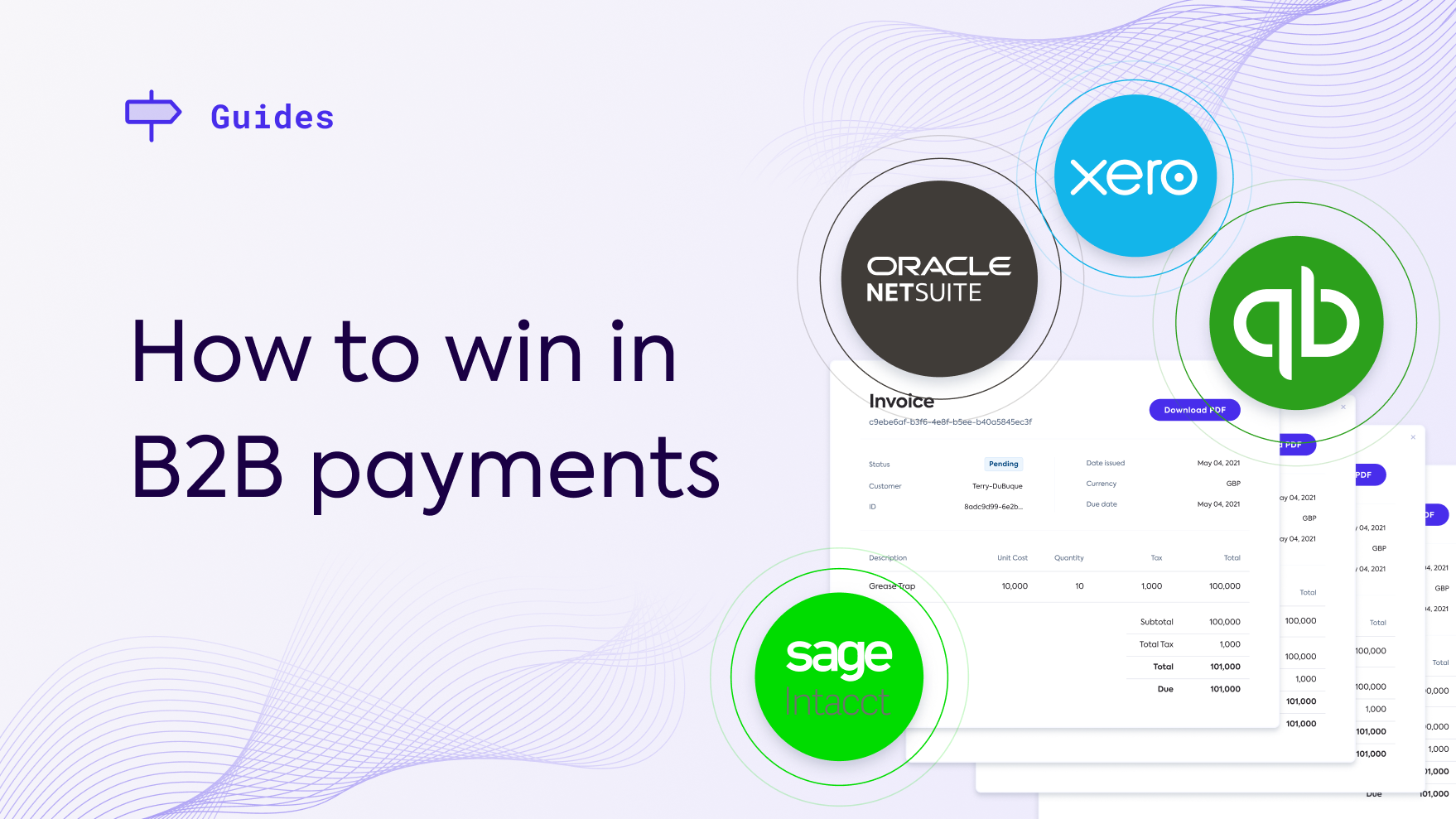
Discover how integrations can help you deliver the best-in-class functionality that your SMB customers now expect.
B2B payments is a particularly broad term that is often used to describe a wide range of players. This includes accounts payable and receivable solutions that help businesses pay vendors and get paid faster, such as Avidxchange and Invoice2go, as well as cross-border payments facilitators such as Western Union and FX payments solutions like Wise. It can also apply to spend management platforms that allow businesses to track and manage company spending such as Ramp, and even online wholesale marketplaces like Faire.
The state of B2B payments today
For too long, B2B payment flows have been hugely inefficient, further intensifying the burden of manual reconciliation for finance teams. For example, 80% of SMB invoices are still paid manually by cheque in the US, and only 25% of invoices are filed electronically in both Europe and America.
The lack of visibility in the payment process is a big problem for small businesses, resulting in as many as 32% making duplicate payments and 60% experiencing reputational damage and supplier friction due to late payments. It’s all the more surprising considering the rapid evolution experienced in consumer payments in recent years.
The consumerization of B2B payments presents a huge opportunity
Current B2B payment volumes are predicted to be around $127 trillion today and will likely rise as high as $200 trillion by 2028, over five times more than the value of consumer payments. Despite this, the industry has historically been slow to digitize in comparison, but this is starting to change.
Due to their enhanced experiences as consumers, business owners’ expectations are evolving – and rapidly. They now expect the same efficiency, visibility, and control from their B2B payment processes.
Problems faced by your merchant customers
When building applications for merchants, connectivity is now considered a minimum entry requirement. The ability to integrate B2B payment platforms with the countless other systems businesses use is pivotal to attracting more and stickier customers.
The providers that stand to benefit the most from the consumerization of the B2B payments industry will be the ones that truly understand their business customers’ evolving needs and leverage integrations to address the following pain points in the process.
1. Data is locked in disparate systems ?
Small businesses now rely on more applications than ever before, including multiple payment platforms. This can turn a seemingly straightforward task, such as reconciling an invoice, into a real chore.
For most SMBs, invoice data exists in their accounting or ERP systems, but these invoices are rarely actually generated here, and the process of reconciling invoices between systems is hardly ever automated. In addition, invoices are regularly received in inconsistent formats, making them difficult to match against purchase orders and contracts, further exacerbating the strain of manual reconciliation for SMBs.
Unfortunately, disconnected processes like this mean that data is rarely up to date and is heavily prone to inaccuracies, resulting in late and even duplicate payments.
2. Accurate management reporting is near impossible ?
Without visibility of their entire payables and receivables pipeline, businesses have little to no understanding of their actual financial health. This has considerable consequences – it can severely limit their ability to forecast their cash flow and schedule upcoming spending accurately, and even result in them having to absorb unwanted and unplanned costs.
3. Post-payment reconciliation is time-consuming and manual ?
Our research shows that as many as 63% of small businesses believe time spent on accounting administration takes them away from growing their business. After all, the average business owner spends an estimated 40 hours on bookkeeping every month. The vast majority of this involves manually updating data in different systems and formats. As a result, even a task like marking a bill as paid takes significantly longer than it should.
Synchronising data into accounting software is a critical requirement
You can solve these problems for SMBs by integrating with their ERP and accounting platforms and automating bill payment and invoicing processes. Doing so makes it easier for your customers to pay outstanding bills using preferred payment methods and saves them considerable time by removing the administrative logjam of manual reconciliation.
You can use integrations to deliver spend analytics across your customers’ transactions. This ensures they have a detailed understanding of their financials on an ongoing basis, enabling them to plan for the future, make more informed decisions, and identify potential growth opportunities.
Solving these problems for SMBs increases adoption and reduces churn as business customers who integrate their accounting software are typically twice as sticky. It also increases the lifetime value of merchants. Eliminating the roadblocks in the B2B payments process provides finance teams with a greater incentive to use these systems for payments and purchases they may not have considered them for previously. The positive results are well documented. For instance, when customers integrated an online purchasing platform with their accounting platform, they were found to spend 30% more, and companies who have connected their Brex card spend 8x more than those that haven’t.
How to overcome your integration challenges
Building and maintaining bi-directional integration infrastructure from scratch is incredibly complex, costly, and time-consuming.
As mentioned above, SMBs now use a wide range of financial platforms. As a result, it can take years to achieve full coverage of all the ERP and accounting systems your customers use. In addition, ensuring all of your integrations remain reliable requires constant focus, which diverts significant resources from enhancing your core product offering.
When determining your integration strategy, it’s crucial to consider the return on investment. Building and maintaining an entire integration ecosystem in-house is expensive; see Codat’s ‘how to build integrations’ guide for more information.
ERP platforms are incredibly complex and highly customizable. As a result, your time and resources will be better spent building and maintaining these integrations for your large enterprise customers and allowing an API expert like Codat to handle the connections to accounting platforms used by smaller merchants like QuickBooks, Xero, Oracle NetSuite, and Sage Intacct.
How Codat can help
Over 200 clients, including leading B2B payment platforms such as Plastiq, Comma, and Melio, are already using our bi-directional APIs to reconcile their merchant customers’ data into their accounting software and help them satisfy their business needs.
Our integrations are robust and time-tested, enabling you to offer the depth and breadth of coverage your business customers need – instantly. In addition, we handle the complexities of integrations, including registration, authorization, standardization, and ongoing connectivity.
Create an account to start building today, or complete the form below to get in contact with our Sales team.

Oleg Makaed, Solutions Engineer
